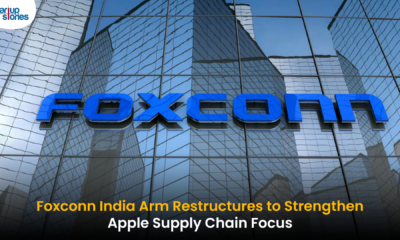News
Flipkart: From A to Finish First

Close to 11 years ago, when the Indian ecommerce ecosystem was still in the nascent stages, one company, with an investment of Rs. 4, 00,000 did not know it would become India’s leading ecommerce player. Launched by IIT Delhi alumnus Sachin Bansal and Binny Bansal, today, Flipkart is valued at $11.6 billion. Slowly but surely, the firm gained investors such as Tiger Global Management, Tencent Holdings and Naspers.
But, the company faced some major competition in these ten years. From Snapdeal to eBay, the Bengaluru based ecommerce firm fought tooth and nail to gain a majority of the Indian online retail market. After a long drawn out battle, last year Flipkart and India’s next ecommerce major Snapdeal almost joined hands to become one entity. However, the deal didn’t come through as the Gurgaon based startup, Snapdeal, wanted to pursue an ‘independent path.’ The silver lining of this merger was Flipkart gained one of it’s biggest shareholders after ending the merger talks with Snapdeal. With backing from Japan’s venture firm SoftBank, US based Microsoft and eBay among other investors, Flipkart was finally prepared to take on the world. However, the company faced a bigger threat in the form of the American retail giant Amazon led by Jeff Bezos.
The Flipkart versus Amazon battle was always present from the very word go. The real war, however, started back in 2015, when both Flipkart and Amazon decided to move into the online smartphone market. At that point, Amazon lost its foothold in the Chinese market, with other ecommerce platforms figuring out they could do what Amazon was doing in a faster and cheaper way.
With that happening on the side, founder and CEO, Jeff Bezos, decided to do whatever it takes to keep their foothold strong in the Indian market. This included signing a cheque worth $ 2 billion to anyone who stood in its way! While this matter in itself was worrisome for Flipkart, the fact that Amazon was entering into the world of smartphones made things exciting.
Over the years, the Flipkart and Amazon war gave rise to a lot of exciting eyeballs, making everyone stand on edge with excitement. Flipkart wanted to be the reason Indians bought products on the Internet. Its focus on technology to solve product ecommerce for the domestic market put it in a league of its own. Even the storied Indian IT and BPO industry derived nearly 90% of its profitable revenues from global enterprise clients.
What makes the two ecommerce platforms stand neck to neck is the fact that the number of coders, as well as the technology used by both the companies. Refined to its core, this battle is a classic “homegrown pioneer vs. giant multinational” story on the grounds of Nirma vs. Hindustan Lever, Thums Up vs. Coca Cola, or Mahindra & Mahindra vs. Toyota Motors; with technology as the mid ground. Flipkart has the scale and local footprint. Amazon has staying power and a platform it has seasoned globally for 21 years.
With SoftBank’s recent investment into Flipkart, the battle stands at an interesting level. As of 2017, the homegrown ecommerce platform raised $ 3.9 billion in two rounds of funding from SoftBank and Tencent. At such a time, even the idea of a potential investment from the biggest retail giant, USA based Walmart would give the boost it requires to beat Amazon once and for all. However, before that could happen Amazon decided to show its hand in the game as well. The Seattle based company recently offered Flipkart a breakup fee of $ 2 billion to convince it to discuss an offer which analysts say would bring with it substantial antitrust challenges, as Flipkart and Amazon dominate the online shopping space in Asia’s third largest economy. Furthermore, Amazon is interested in buying about 51 to 55 % stake in the ecommerce platform. Whichever way the deal plays out, it is safe to say Flipkart has garnered a great deal of attraction from the international ecommerce marketplace.
Whether the deal goes through between Flipkart Amazon.com Inc., or with Walmart and Flipkart, it will be the biggest deal made by a US based company in terms of buying out another similar online platform. Regardless of how this flips, it would also be a win win situation for the Indian ecommerce company!
News
Google Launches Startup Hub in Hyderabad to Boost India’s Innovation Ecosystem

Google has launched the Google Startup Hub Hyderabad, a major step in strengthening India’s dynamic startup ecosystem. This new initiative aims to empower entrepreneurs, innovators, and developers by giving them access to Google’s global expertise, mentoring programs, and advanced cloud technology. The hub reflects Google’s mission to fuel India’s digital transformation and promote innovation through the Google for Startups program.
Located in the heart of one of India’s top tech cities, the Google Startup Hub in Hyderabad will host mentorship sessions, training workshops, and networking events designed for early-stage startups. Founders will receive Google Cloud credits, expert guidance in AI, product development, and business scaling, and opportunities to collaborate with Google’s global mentors and investors. This ecosystem aims to help Indian startups grow faster and compete globally.
With Hyderabad already home to tech giants like Google, Microsoft, and Amazon, the launch of the Google Startup Hub Hyderabad further cements the city’s position as a leading innovation and technology hub in India. Backed by a strong talent pool and robust infrastructure, this hub is set to become a growth engine for next-generation startups, driving innovation from India to global markets.
News
BMW’s New Logo Debuts Subtly on the All-Electric iX3: A Modern Evolution

BMW quietly debuted its new logo on the all-electric iX3, marking a significant yet understated shift in the brand’s design direction for 2025. The updated emblem retains the classic roundel and Bavarian blue-and-white colors, but sharp-eyed enthusiasts noticed subtle refinements: the inner chrome ring has been removed, dividing lines between blue and white are gone, and the logo now features a contemporary satin matte black background with slimmer “BMW” lettering. These enhancements showcase BMW’s embrace of modern minimalism while reinforcing their commitment to premium aesthetics and the innovative Neue Klasse philosophy for future electric vehicles.
Unlike rival automakers that reveal dramatic logo changes, BMW’s refresh is evolutionary and respectful of tradition. The new badge ditches decorative chrome and blue borders associated with earlier electric models, resulting in a flatter, more digital-friendly design that mirrors recent branding seen in BMW’s digital communications. Appearing first on the iX3’s nose, steering wheel, and hub caps, this updated identity will gradually be adopted across all BMW models—both electric and combustion—signaling a unified brand language for years to come.
BMW’s strategic logo update represents more than just aesthetic reinvention—it underscores the brand’s dedication to future-ready mobility, design continuity, and a premium EV experience. As the new roundel begins rolling out on upcoming BMW vehicles, it stands as a testament to the automaker’s depth of detail and thoughtful evolution, offering subtle distinction for keen observers and affirming BMW’s iconic status in the ever-changing automotive landscape.
News
iPhone 17 India Price, Features & Availability: All You Need to Know

Apple has officially launched the highly anticipated iPhone 17 series in India, with prices starting at INR 82,900 for the base 256GB model. The new lineup includes the iPhone 17, iPhone 17 Pro, iPhone 17 Pro Max, and the newly introduced ultra-slim iPhone Air. Apple has removed the 128GB storage variant, making 256GB the minimum for all models. The standard iPhone 17 features a vibrant 6.3-inch ProMotion OLED display with a 120Hz refresh rate and an upgraded Ceramic Shield 2 for improved durability. It comes in fresh color options like lavender, mist blue, sage, white, and black.
The iPhone 17 Pro and Pro Max models are powered by Apple’s latest A19 Pro chip and start at INR 1,34,900 and INR 1,49,900, respectively. These Pro models feature sleek titanium frames, significant camera upgrades including 8K video recording, and up to 6x optical zoom in the Pro Max. Meanwhile, the iPhone Air, priced from INR 1,19,900, is the slimmest and lightest iPhone ever, boasting a 6.7-inch Super Retina XDR display with ProMotion technology and a triple-camera setup, positioning itself between the standard and Pro models.
Pre-orders for the iPhone 17 series commence on September 12, with sales beginning on September 19, 2025. Alongside the launch, Apple has reduced prices for the previous iPhone 16 models while discontinuing the iPhone 16 Pro and Pro Max variants. The iPhone 17 series exemplifies Apple’s ongoing commitment to enhancing display technology, camera capabilities, and overall performance, setting a new benchmark for premium smartphones in the Indian market.















Kuwin
November 5, 2025 at 8:55 pm
kuwin sở hữu kho game đa dạng từ slot đến trò chơi bài đổi thưởng, mang đến cho bạn những giây phút giải trí tuyệt vời.
iwin
November 6, 2025 at 6:36 am
iwin – nền tảng game bài đổi thưởng uy tín, nơi bạn có thể thử vận may và tận hưởng nhiều tựa game hấp
站群程序
November 8, 2025 at 3:09 am
搭载智能站群程序,自动化搭建与管理,为SEO项目提供核心驱动力。站群程序
谷歌蜘蛛池
November 13, 2025 at 4:10 am
利用强大的谷歌蜘蛛池技术,大幅提升网站收录效率与页面抓取频率。谷歌蜘蛛池
J88
November 13, 2025 at 11:25 am
Đến với J88, bạn sẽ được trải nghiệm dịch vụ cá cược chuyên nghiệp cùng hàng ngàn sự kiện khuyến mãi độc quyền.
MM88
November 13, 2025 at 10:49 pm
Với giao diện mượt mà và ưu đãi hấp dẫn, MM88 là lựa chọn lý tưởng cho các tín đồ giải trí trực tuyến.
MM88
November 14, 2025 at 10:43 pm
Khám phá thế giới giải trí trực tuyến đỉnh cao tại MM88, nơi mang đến những trải nghiệm cá cược thể thao và casino sống động.
online Gambling
December 18, 2025 at 11:33 pm
online Gambling online Gambling
kostenloses startgeld casino 2026
December 21, 2025 at 9:45 am
In einigen Ländern liegt das Mindestalter bei 18 Jahren, während in anderen Staaten ein höheres Alter erforderlich ist,
um Casinos zu besuchen. In den meisten Ländern liegt das Mindestalter
bei 18, aber es gibt Ausnahmen wie die USA, wo oft 21 Jahre erforderlich sind.
Dieser Vertrag legt fest, dass das Mindestalter für die Teilnahme an Online-Casinospielen bundesweit 18 Jahre beträgt.
Interessant ist, dass Casinos in der Schweiz strengen Kontrollen unterliegen, um sicherzustellen, dass nur Personen ab diesem Mindestalter spielen dürfen.
Die Auszahlung erfolgt direkt am Automaten oder über
das Casino Personal für höhere Gewinne. Beliebte Spiele wie Jin Ji Bao Xi Grand und Aladdin’s
Fortune versprechen neben hohen Gewinnen auch ein packendes Spielerlebnis.
Von den klassischen Walzen-Slotmaschinen bis zu den modernen Video-Spielautomaten, das Casino deckt alle Vorlieben ab.
References:
https://online-spielhallen.de/die-grose-amunra-casino-bewertung-ein-detaillierter-blick/
Posido Casino Registrierung
December 21, 2025 at 12:17 pm
Es bietet eine große Auswahl an Spielen, darunter Slots, Tischspiele und Leben-Dealer-Optionen. 888 Casino hat eine
große Auswahl an Spielautomaten, Tischspielen und Leben-Dealer-Optionen. Es bietet spannende Spiele,
große Boni und eine sichere Plattform. Im Vergleich
zu anderen Die besten Online Casinos bietet 888casino durchweg großzügigere und
leichter zugängliche Boni.
Wenn Sie mit uns spielen, genießen Sie ein erstklassiges Erlebnis.
Das 888 Online Casino bietet zusätzlich immer wieder Sonderaktionen und Extraboni, beispielsweise auch bei den Live Spielen. Klicken Sie während der Einzahlung einfach auf „Bonus anfordern“ und Sie erhalten eine E-Mail, über die
Sie den Bonus aktivieren können. Bis auf
die Live Casino Spiele und die progressiven Jackpots können Sie alle
Games im 888 Online Casino kostenlos spielen. Dabei spielt es keine Rolle, ob Sie mit Ihrem Computer oder per
Handy im Online Casino spielen. Ich rate dringend von der
Nutzung von 888casino in Österreich ab, da das
Unternehmen ohne gültige österreichische Lizenz
operiert und somit gegen das österreichische Glücksspielgesetz (§ 3 GSpG) verstößt.
Natürlich bin ich mir dessen Bewusst, dass Fehler passieren können & mein „erhaltener
Bonus“ mehr oder weniger ein Geschenk gewesen ist.
Der Freundliche Mitarbeiter teilte mir sein bedauern über den entsandenen Fehler mit und versicherte mir,
dass meine Anfrage unter hoher Priorität behandelt werden wird, es jedoch bis zu 72h dauern könnte eine
Antwort via Email zu erhalten. Am nächsten Tag auch gleich
mit dem Kundensupport via live chat Kontakt aufgenommen und alles inkl.
In meinem Fall handelt es sich um einen 40€ Freeplay Bonus den ich als Geburtstagsgeschenk erhalten habe.
888 zeigt sich hier leider völlig uneinsichtig und handelt aus meiner Sicht intransparent und unseriös.Ich habe daher die österreichische Finanzmarktaufsicht
(FMA) sowie das Europäische Verbraucherzentrum
(ECC) eingeschaltet. Spiele fehlerhaft schmeißt dich immer
raus nur Verluste und wenn man ihnen eine Email schreibt kommt nichts zurück von denen schreckliches casinoWarte auf meine Rückzahlung Email Adressen stimmen auch nicht mehr
References:
https://online-spielhallen.de/kings-casino-rozvadov-spiele-events-e1m/
best players in premier league 2026
December 26, 2025 at 5:28 pm
With this robust framework in place, Bizzo Casino provides a secure environment for players to enjoy their gaming experience,
backed by reliable customer support and transparent
terms of service. Uncover the allure of diverse games and enticing bonuses, discover
the secure banking options, and witness the responsive customer support that defines the Bizzo experience.
Its extensive games list is a testament to its commitment to providing Australian players
with a premium gaming experience. Discover an array of games accompanied by alluring bonuses for new players.
Check the promotions page regularly to stay updated on the latest Bizzo Casino Bonus offers!
Players can enjoy exciting rewards with every Bizzo Casino
Bonus. Before playing at Bizzo Casino, users should check the terms and conditions.
It uses encryption technology to protect transactions and player data.
Online gambling laws in Australia focus on regulating local operators.
It operates under a valid gaming license from a reputable offshore authority.
References:
https://blackcoin.co/paysafecard-casinos/
craps betting strategies
December 26, 2025 at 9:21 pm
Audits by independent companies and partnerships with reputable payment providers further enhance player trust and minimize
risks. For example, the New South Wales Independent Liquor
and Gaming Authority emphasizes transparency and
fairness in gambling operations. Services like PayPal, Neteller, and
Skrill are favored for their ease of use and instant deposit capabilities.
Of course, as you might expect, as with any other $5
deposit bonus casino, there are a few terms and conditions to be
aware of. Here, the casino gives the punter a percentage of the amount they
deposited as a bonus. These are rewards that players get for registering on a new gambling platform.
Although casinos in Australia may accept $5 deposits, they may not always
accept it with every payment method. There is an almost unlimited
stash of games on 7Bit, including pokies, Roulette,
Blackjack, Baccarat, Video Poker, live games, scratch cards and lots more.
References:
https://blackcoin.co/casino-sign-up-bonuses-2025-the-ultimate-guide/